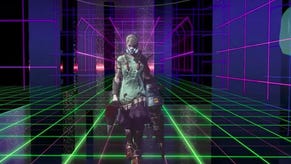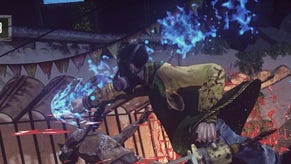Could Suda 51's Let it Die set a new standard for F2P action games on console?
Grasshopper's latest shifts monetisation models without missing a beat.
Lollipop Chainsaw and No More Heroes director Suda 51 is known for taking risks. His studio Grasshopper Manufacture has created some of the strangest games out there from the surreal puzzle adventure Flower, Sun and Rain to the bonkers horror shooter Killer 7, you know a Suda title is always going to be a unique prospect. The mad maestro's latest concoction, the "survival action" third-person combat game Let it Die, is one of his most daring offerings yet, though not due to the game's actual content.
The bizarre third-person action affair contains all the usual surreal Suda touches - you start each life in your skivvies and eat live frogs to regain health - but its most audacious take is its payment structure: this is a free-to-play asymmetrical console title coming exclusively to PS4.
That's a pretty daring notion in an age where "free-to-play" on console often has a stigma of shovelware or "pay-to-win", but Suda and co. are hoping to change that bias with what seems like a shockingly polished entry in the action genre.
Unfortunately, Suda and publisher Gungho Online Entertainment aren't talking monetisation details quite yet, but the director offered the following explanation, via translator, in an interview with Eurogamer at PAX East:
"We can't say too much about the free-to-play monetisation aspects of the game, but one of the things you can buy as a monetised item is continues when you die. The other thing we want to focus on is making sure the game is not 'pay-to-win', so the biggest thing we're looking at for monetisation is to shorten the grind of getting resources."
Suda also noted that despite the game's roguelike structure anything you pay money for - whatever that might be - will be permanent. "We want to make sure that you don't lose things that are monetised for," he says. "There are things that are permanent, so if you die playing you're not going to lose everything every time."
While the monetisation details are mum, what I can say - based on a 20-minute demo - is that Let it Die certainly doesn't feel like the sort of sloppy, grindy, repetitive drivel we typically associate with the skepticism-inducing payment model.
Let it Die features a story-driven campaign in which players ascend a tower full of procedurally-generated levels that has been mysteriously erected in Tokyo. You start each life in your underpants and receive weapons and armour from enemies you defeat. Occasionally you'll come upon a foe whose stats and gear are manifested based on another player who has fallen in their own game - sort of like the invader system in Dark Souls mixed with Forza's player-mimicking "Drivatar" AI.
That's not the only thing Let it Die has cribbed from From Software's popular series. The familiar flow of targeting a foe, circle-strafing and dodge-rolling away feels similar to Bloodborne and while I didn't come across any shields in the demo, you can block incoming attacks by holding the attack button while standing still.

The weapons themselves feel properly empowering with plenty of oomph as you smack a thug upside the head with a baseball bat, slice open a geyser of blood with a katana, or smash a foe to the ground with an axe. There's even projectile weapons like pistols and nailguns, though I found these to be less effective than you might think due to the game's cramped corridors and enemies who prefer close-quarters combat. You're rarely at a loss for options, however, as you can equip up to six weapons at a time (with three in each hand), though some require both hands to wield.
There are still a few rough spots, like the lock-on targeting system which seems a little finicky at the moment, but that's a minor niggle. As is the fact that Let it Dies' stamina meter - dictating your attacks, blocks, sprinting and evasive maneuvers - is represented by your character's weirdly transparent heart that drains from a full red to a medium yellow to a low... purple? Okay.
So there's a bit of that typical Suda roughness mixed in. That slightly unpolished feel that makes it clear that the delectable director is working off the grid with a smaller team than we typically see develop triple-A products. But we're used to seeing this - and accepting it - in his full-priced retail games. Here it's even more excusable (not to mention that I only played an early build). If the brief PAX East demo is indicative of the quality we can expect from Let it Die, then the free-to-play console market may have a new gold standard come this autumn.














.png?width=291&height=164&fit=crop&quality=80&format=jpg&auto=webp)



